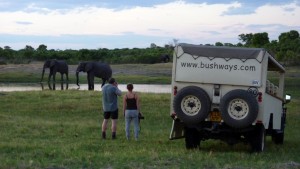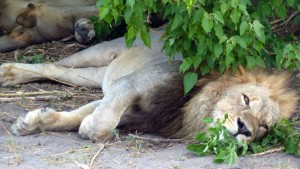Bush Ways Safaris & Mayonnaise – on safari in Savuti and Khwai
Bush Ways and Mayonnaise
“Who wants mayonnaise? ‘ Masters asks. There’s a moment of silence where all five of us fail to jump on his offer. ‘It’s good for the eyes!!!’ he says, putting another spoonful on his dinner and passing the jar down the table. ‘If you don’t see any animals tomorrow, you know who to blame.”
We’ve just arrived in Savute. It’s the end of October, it’s HOT and we’ve just met Masters who will guide us through this area and later on to Khwai. We’ve also just learnt Masters’ best-kept secret for spotting game, except that he isn’t too concerned with keeping his trick in the bag.
We had returned from an incredible sunset over a waterhole which we shared with a cross-legged elephant and a few roan antelope. As Masters had pulled out the G&T the roan scattered and herds of impala sprinted out of the background. “See’ said Masters ‘we were so lucky to see that Roan. If we’d turned up a little later, we wouldn’t have seen anything at all.”
We were quickly learning that this was the advantage of being on a mobile safari, spending two nights in each area, driving around the same corners but seeing different things on the horizon each time. Just when we’d begun to recognise the roads and game patterns in one area, we’d travel to the next campsite and look for it all again on a different backdrop, but with the same guide who understood what we’d already seen and where we’d already been. If we hadn’t seen something yet, Masters usually had a quick solution. When we put hyenas on our wish-list he pointed to his shirt and grinned, “It’s the Bushways logo! You’ve already seen one.”
In the wide-open space of the Savute marsh we spent our time chasing wildebeest, watching elephants sleeping standing up against trees, a big male lion bending a branch under his chin for a pillow and wild dog collapsed in a mess of legs and ears under the closest shade they could find. The animals regarded us vaguely but didn’t bother stirring as our cameras clicked away. Despite the intense heat which kept most animals in the shade, we came across plenty of elephants butting their heads against trees, hippos yawning out twisted laughter and a herd of buffalo big enough to be counted at a thousand, give or take a few. “That’s my favourite animal’ said Masters ‘because with that one…eish…the buffalo doesn’t mock charge, so if he comes for you, it’s already too late!” The rest of our group had already heard these tales in Chobe, spending their first night on safari wide awake as buffalo entered the campsite and Masters’ tales repeated in their minds.
On the road between Savuti and Khwai we watched green open spaces turn to long yellow grasses and closed-in mopane forest before stopping for tea in open grasslands of the Mababe Depression. The landscape was yellow and the sky a blazing blue that formed mirages on the horizon. “As soon as the rain starts, this place is green, green, green and full of thousands of zebra and wildebeest.” It was hard to imagine that we were only a few weeks away from a complete landscape change that would come with the first rains.
Arriving in Khwai, Masters found us seven lions under a tree, across the road from two signs pointing in opposite directions. “Welcome to Chobe” on the left and “Moremi Game Reserve – 20kms” on the right with no fences in between to impede the animals’ movements.
The lions were almost impossible to see, even as we stared straight at them camouflaged in the yellow grass. “It’s because I eat mayonnaise” Masters reminded us. As we jumped out of the vehicle on the Khwai River for sundowners, there was a burst of activity on the radio and Masters bundled us back in the car “There’s a leopard over that way…let’s go!” As the sun dipped towards the horizon, we bumped along off-road and came upon a female leopard making contact calls. We watched her as she jumped up on branches, circumnavigated termite mounds and prowled around the vehicle. Heading over to our campsite in the now pitch-black night, Masters told us to look for shining eyes as he moved his flashlight across the bush. Impala, impala…more impala, then suddenly several pairs of eyes caught the light and we found ourselves amidst ten or so spotted hyena fighting over the carcass of a baby elephant. We sat and watched as their curved ears caught the torchlight and they pulled meat from the carcass, rocking it back and forth in a little tug of war. “See?’ says Masters “Bushways watching Bushways!”
Just as we’d thought we were done for the night, a civet ran across the road in a spotted blur and we arrived back at our campsite to find our tents made up, our showers ready and food almost on the table.
Over dinner we discussed food, “I don’t understand how you foreigners each so much’ Masters said piling the mayonnaise on his dinner ‘if we do that, we get fat.” We tried to protest that people don’t normally eat us much as they do on safari, but he cut us off, ‘did you eat your mayonnaise? If we don’t see anything tomorrow, you know who to blame!” By now, Masters has made his point and everyone around the table takes a spoonful.
The next day we see the hyenas again, sleeping under bushes as vultures move in on the baby elephant. In the daylight we can see the tiny protrusions of the elephant’s milk tusks from the skull. We see waterbuck, giraffe, zebra, red lechwe, hippos, warthog, Egyptian geese, bateleur eagles and saddle-billed storks. We stop for a mokoro excursion in the afternoon and everyone comes back with water lily necklaces and hats. That night we see the spotted hyena again, munching on baby elephant for the second night in a row.
On our last night we’re a little sad to think it’s back to the real world where we don’t find ourselves in the middle of herds of antelope, elephant, wildebeest and buffalo every day. We hear hyena calling in the night and lions roaring close by in the morning. We’re all excited over breakfast, hoping to catch the lions before we leave.
For a long time we find nothing. We visit the spot where we found the lions last. Nothing. We drive several tracks looking for spoor. Nothing. We turn the next corner and meet a vehicle hurtling down the track, the guide behind the wheel motioning for us to follow. We pick up the pace and arrive at a clearing in the bush where two lionesses are running across the clearing, herding their cubs off. “This is interesting’ says Masters ‘they’re nervous about something.” He moves the vehicle and we see three big male lions in the bushes. “I think they’re trying to kill the cubs so they can mate with the females” he says. We watch as the lioness lead their cubs quickly off, stopping, looking over their shoulders and moving further into the brush. Masters moves the vehicle to where he thinks they may emerge from the shrub and sure enough, a few minutes later they walk right past us. Masters giggles and gets on the radio ‘they’re walking towards our campsite’ he says, ‘I need to radio the camp staff to get in the car.”
“I think they might go to the river for a drink’ says Masters, putting the car in gear. It’s a guess that pays off. As Masters parks by the river we wait a little while and sure enough, the lions emerge. “The girls might just take their cubs across the river for safety. Those big male lions will try to track them. This isn’t something you see often, cats don’t like getting wet and crocodiles are a threat to them too.”
The lioness round up their cubs and take them to the narrowest part of the river, belly-flopping into the water and beginning to paddle. Very soon, all nine are treading over to the other side. We’re feeling a bit inspired and all cheer ‘mayonnaise!’ as the lions emerge looking soggy and worried before disappearing into the Moremi Game Reserve on the other side of the Khwai River. A moment later we’re also on the road out of Khwai, heading back to the real world on the calcrete road to Maun.
Bushways Fully Serviced Mobile Safari
6 Nights in Khwai, Savuti & Chobe
Combine with: Victoria Falls and the Okavango Delta on our 10N Authentic Lodge & Mobile with optional extension to Meno a Kwena on the Boteti River/Makgadikgadi NP.
Access: from Maun or Kasane/Vic Falls or Livingstone with Northbound and Southbound departures throughout the year.





